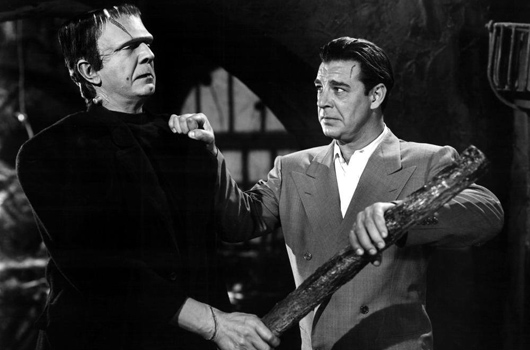
Frankenstein Meets the Wolf Man (Universal 1943)
Sounding more like comic-book japes than a serious classic monster film, Frankenstein Meets the Wolf Man is surprisingly good. Anecdotal evidence from screenwriter Curt Siodmak suggests the idea was initially presented by him as a joke to producer George Waggner as he needed a new car. “I was sitting down at the Universal commissary having lunch with [him] and I said, ‘George, why don’t we make a picture Frankenstein Wolfs the Meat Man – er, Meets the Wolf Man?’”
Waggner took him up on his idea and announced his new writing job was indeed to be Frankenstein Meets the Wolf Man, on the very day payment fell due for his car.
Bela Lugosi’s features are clearly visible through Jack Pierce’s Monster make-up for Frankenstein Meets the Wolf Man (Universal 1943)
The first of what would come to be known as the Universal monster rallies, Frankenstein Meets the Wolf Man is arguably one of the stronger horror films of the genre, and certainly the best of the multi-monster mashes. With an excellent cast generally, and a superlative performance by Lon Chaney, the film, directed by Roy William Neill, is at times visually stunning and beautifully scripted.
Although the casting of Bela Lugosi as the Monster is a sad irony given that he rejected the role in 1931, it’s a decision that would seem to make perfect sense on paper, given that Ygor’s brain is now in the Monster’s skull. That the star’s performance is awkward and stilted is lamentable as at face value, it was a dip in his usual solid, if undervalued, body of work. Sadder still are the contributing factors to this outcome, most importantly the fact that Siodmak’s original screenplay had a substantial amount of dialogue for the Monster, all of which was ultimately excised from final prints.
Grave robbers Cyril Delevanti and Tom Stevenson attempt to steal from the ‘corpse’ of Lawrence Talbot in the chilling opening scene of Frankenstein Meets the Wolf Man (Universal 1943)
This articulate creature, more akin to Mary Shelley’s original than any Universal depiction before or since, explains to Larry Talbot whilst warming his hands over a fire how miserable he is at the loss of his sight and strength, and how difficult his years trapped in the ice have been. There are several more scenes of dialogue, which were essential for both continuity of the story and as reference for Lugosi’s style of playing the Monster.
Derided by a hysterical crew during original test screenings, Neill ordered that all scenes of Lugosi’s dialogue be cut, but unfortunately, with them, all context of the Monster’s impaired vision and his possessing Ygor’s brain vanished too. The net effect was to make Lugosi’s lumbering, outstretched gait and silently mouthing odd lines which couldn’t be cut look rather ridiculous. Adding to the confusion is the fact that while Lugosi played the character as virtually blind, no such instructions were given to his stunt double, Eddie Parker, whose scenes were carried out as a fully-sighted Monster. Whether the removed scenes were as ludicrous as events suggest, the main objection apparently being Lugosi’s thick Hungarian accent, is open to conjecture; surely it would seem perfectly natural for the Monster to now speak with Ygor’s voice.
Larry Talbot (Lon Chaney) goes on the rampage in Cardiff after escaping from the city’s Queen’s Hospital in Frankenstein Meets the Wolf Man (Universal 1943)
Notwithstanding this inescapable weakness in Frankenstein Meets the Wolf Man, the film’s great strengths carry it forward as a winner. Both Ilona Massey and Patric Knowles are wonderful as support leads, as are the majestic Maria Ouspenskaya and the measured Dennis Hoey. Lionel Atwill, amid the sex scandal that would sadly blight the rest of his life and career, is excellent as ever as the unnamed mayor of Vasaria. Poor Dwight Frye is seen for the last time as a leering, overly anxious villager; the actor died from a heart attack just months after the film wrapped. It’s a melancholy reflection that his role was to have been bigger and more plausible in Frankenstein Meets the Wolf Man; sadly, Universal decreed this was not to be, and Frye’s desire to get a decent role before he went “screwy playing idiots, half-wits and lunatics” was to remain unfulfilled.
Having been pursued to the Frankenstein ruins, the Wolf Man (Lon Chaney) discovers a glacial underground ice cavern in Frankenstein Meets the Wolf Man (Universal 1943)
The opening scene of Frankenstein Meets the Wolf Man is the stuff of pure traditional gothic horror films. Excellent camerawork by George Robinson gives us a single panning shot of Llanwelly Cemetery as vagrants Cyril Delevanti and Tom Stevenson break into the Talbot crypt to steal a valuable ring from the corpse of Lawrence Talbot (Chaney), who died some fours previously. They discover the lycanthrope’s body to be strangely preserved, and as the full moon rises and shines through a window, Talbot returns to life, murdering one of the grave-robbers as the other frantically flees.
Cut to the far-off city of Cardiff and the discovery of Larry’s slumped body in the street, resulting in his waking up in Queen’s Hospital under the care of Dr Frank Mannering (Knowles). With his amnesia slowly abating, and the murder of a local policeman under his belt, the hapless Talbot becomes reacquainted with his lunar tendencies, but Mannering, along with local inspector Owen (Hoey) is having none of it. However, travelling to Llanwelly, they discover Talbot’s tomb to be empty, and in their absence, Larry absconds, having bitten his way through his straitjacket.
Dr Mannering (Patric Knowles), Baroness Elsa Frankenstein (Ilona Massey) and gypsy woman Maleva (Maria Ouspenskaya) arrive at the castle to help Larry Talbot and to destroy the Monster in Frankenstein Meets the Wolf Man (Universal 1943)
Desperate to find a way to die, Talbot scours Europe in search of Maleva (Ouspenskaya), who, although admitting she cannot help him herself, suggests they travel to Vasaria to consult with Dr Frankenstein, insisting she will take care of him until he can find release. Their welcome in the town on their arrival is not particularly warm and, after murdering local girl Margareta (Martha Vickers), the Wolf Man finds himself pursued to the ruins of Frankenstein’s sanitarium in the mountains, where he tumbles into an underground glacial cavern. His lycanthropic fit over, he is astounded to discover the Frankenstein Monster (Bela Lugosi, although clearly in this scene stuntman Eddie Parker) frozen in a block of ice, and immediately sets about freeing him. The creature revived, Talbot asks him the location of the Frankenstein records and, although he tries to help, the Monster is unable to locate them.
The revived Monster (Bela Lugosi) attempts to locate the Frankenstein records in Frankenstein Meets the Wolf Man (Universal 1943)
Posing as potential purchaser Larry Taylor, Talbot secures a meeting with Baroness Elsa Frankenstein (Massey) via Vasaria’s mayor (Atwill). Once alone with her, he comes clean and confesses he merely wants her father’s diary. She refuses to help him, but the two remain in town to attend the Festival of the New Wine with the mayor as their host. Amid the festivities, the Monster comes a-strolling into town, creating panic among the locals. Talbot bundles him into a cart and drives him back up to the ruins with the villagers in hot pursuit.
As the Monster bears off the Baroness (Ilona Massey) the features of stuntman Gil Perkins can clearly be seen in place of Lugosi’s, despite Jack PIerce’s heavy make-up, in Frankenstein Meets the Wolf Man (Universal 1943)
Collaborating with Elsa and Maleva, Mannering agrees to help Talbot end his life and at the same time drain the Monster of his energy for the good of the town. However, in a freaky if not completely unexpected mad-scientist moment, he determines to see Frankenstein’s creation at its full power, much to the chagrin of Elsa. By reversing the poles on the newly-restored equipment, Mannering achieves this end and restores the Monster’s strength, allowing it to break free and menace the baroness.
As the full moon rises, Talbot transforms into the Wolf Man and, breaking free himself, engages in a vicious battle of the titans. Elsa and Mannering escape as villager Vazec (Rex Evans) blows up the dam above the ruins, causing huge torrents of water to wash down and sweep the two combatants away to their apparent destruction.
The iconic publicity shot showing the Battle of the Titans in Frankenstein Meets the Wolf Man (Universal 1943)
Sporting the best Wolf Man transformation scene in the whole series, by use of a plaster cast pillow and careful fades, Frankenstein Meets the Wolf Man is almost on a par with its predecessors in terms of quality and overall production values. Unfortunately, the flaws it does have are rather too glaring to conveniently overlook, and these mar what could otherwise be a masterpiece. The frail Lugosi wasn’t really up to the role of the Monster, and his stunt double Eddie Parker is anything but a double, making a clear distinction between which scenes are his and which Lugosi’s. The brazen use of Parker in the first glimpse we get of the creature draws more attention to this fact than may otherwise have been apparent, and the situation doesn’t improve in the final battle scene when Parker switches sides to become the Wolf Man, leaving Gil Perkins to fill the Monster’s boots. This aside, the climactic finale is a joy to watch and, with an energetic score by Hans J Salter, makes for an exhilarating piece of cinema.
So very nearly a perfect film, Frankenstein Meets the Wolf Man is still infinitely better than many of its critics, at the time or since, will deign to admit. Lambasted for being the first of the monster line-ups, and therefore the beginning of the end of the classic monsters, it’s hard to see where, by 1943, they were going anyway.
Original theatrical release poster for Frankenstein Meets the Wolf Man (Universal 1943)










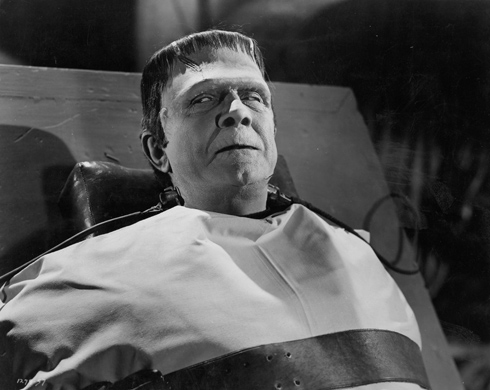
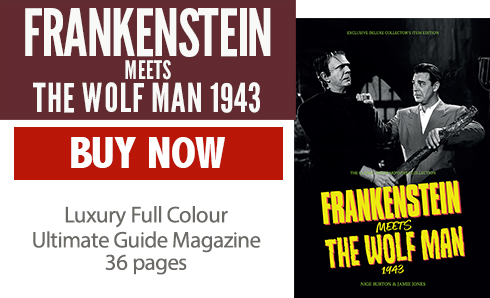
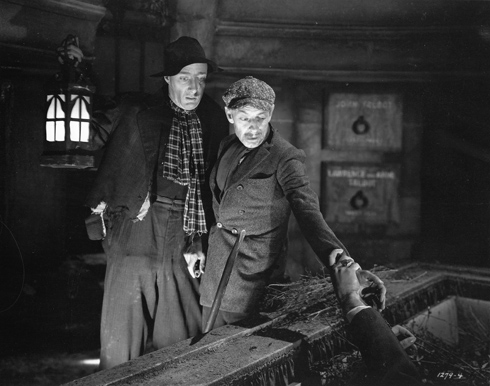

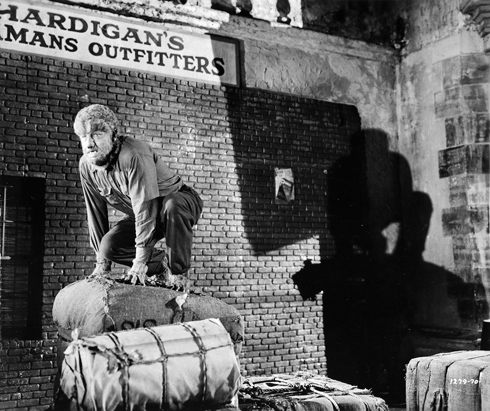
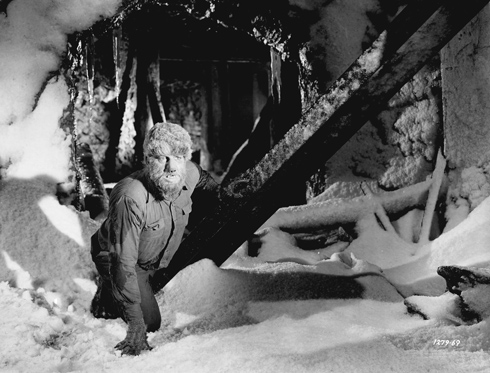

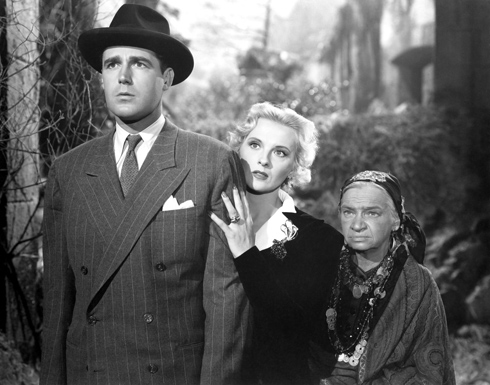
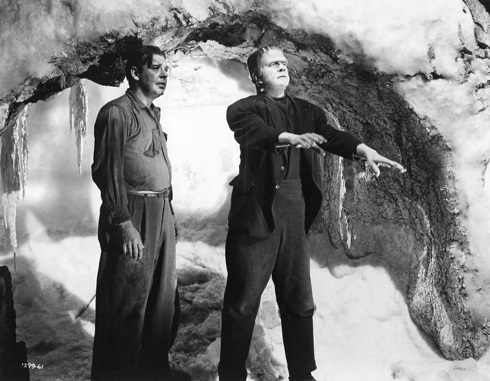
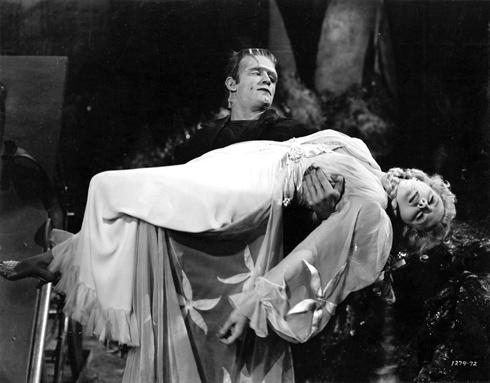

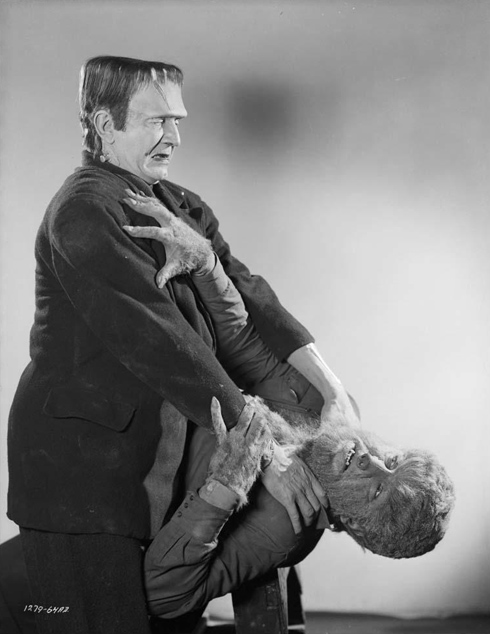

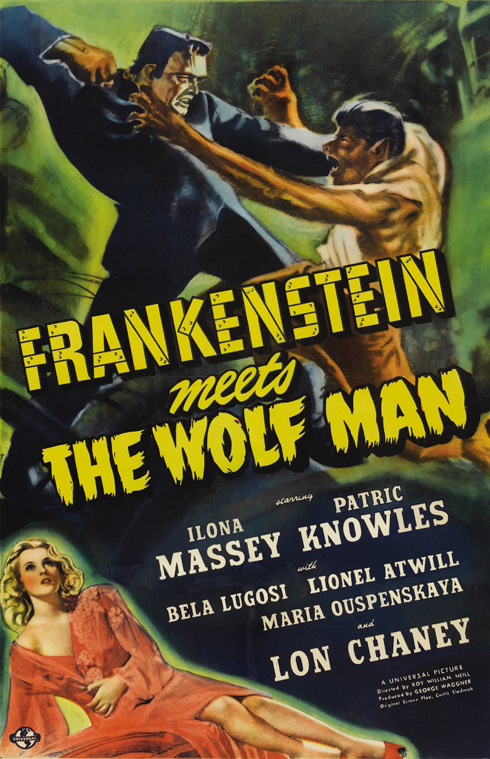
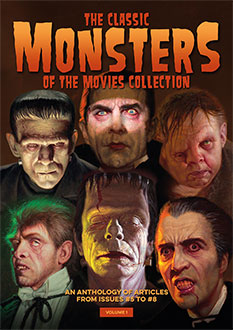
I always thought (and still do) that the monster got its strength back from the Wolfman. That is why the Wolfman struggles to break the straps holding him on the table.
Even now, I still really enjoy this film. It is filled with all the stuff that made the Universal classics, music score, the irate villagers, wild eyed werewolf and a damaged Frankenstein monster. Always a fun time!
Although the Bride of Frankenstein is arguably the apex of the Frankenstein films in terms of plotline and scripting, FMtW is a visual feast for the eyes and ears. The score, by Hans Salter, is a work of genius! The opening scene of the grave robbers is underpinned by eerie and brilliant music, which almost hints of Schoenberg. Esmeralda has her own them – beautiful gypsy violin. The Baroness is exquisitely beautiful, all would agree! The song and scenery of the Festival of New Wine is almost Wagneresque. (Did Hans Salter write the festive song that the strolling gypsy sings? If so, incredible! The Festival scene is beautifully conceived and ambitiously produced. I do not feel that Lugosi’s performance is lacking in any way, in fact, perhaps the most frightening image of the monster ever. I wish the soundtrack of FMtW existed, sans dialogue. For the above reasons, this is my personal favorite of the Frankenstein films, despite a few flaws here and there. JS
this was always my favorite of all the Universal horror flicks. the closest that comes to this was Abbott and Costello meet Frankenstein.
Ilona Massey played a great part as the doctor’s daughter. I find it awesome that the 60 year old Lugosi put on the makeup and received a bit of respect as the monster (he was offered the part in the 1931 original). Yet, Lugosi was only used in about 30% of the movie. Stunt men Eddie Parker and Gil Perkins filled in for the more physical parts… it’s p\Perkins you see first under the ice when Talbot finds him. All in all… one of my favorites.